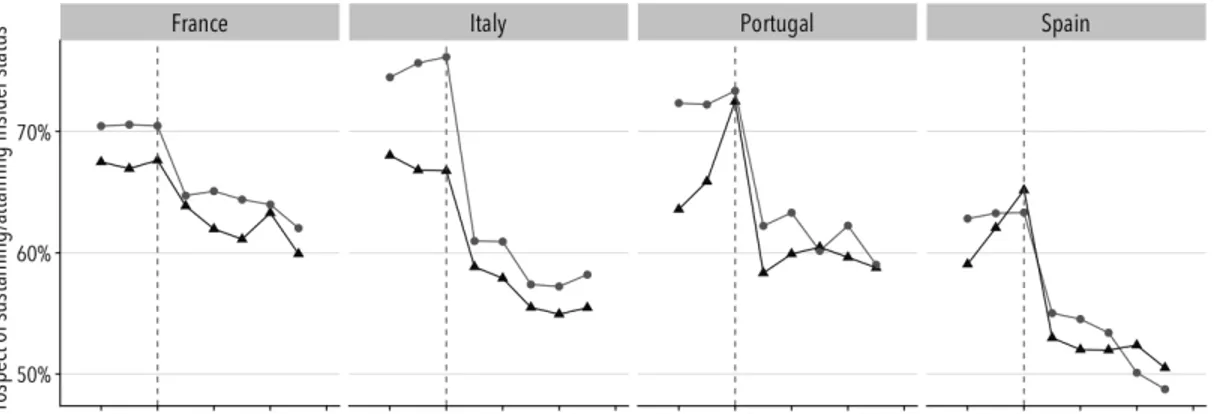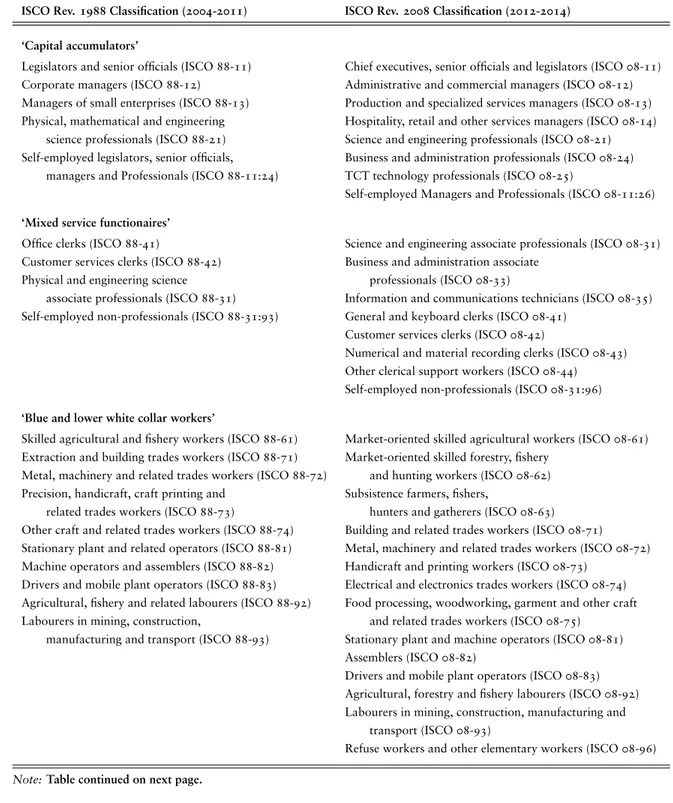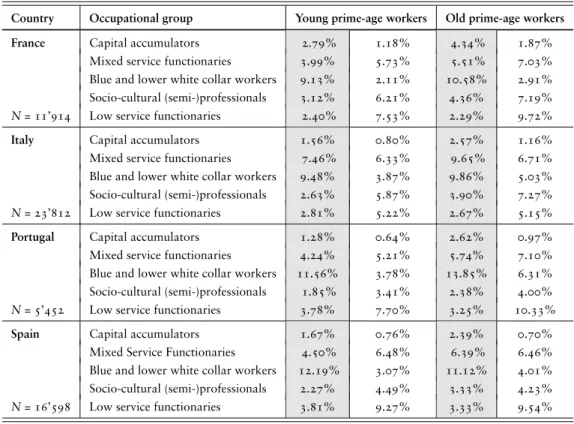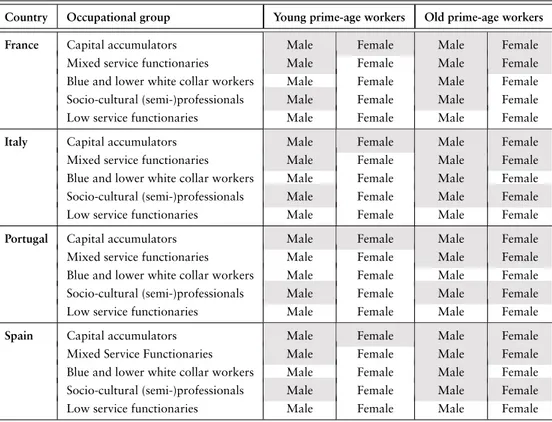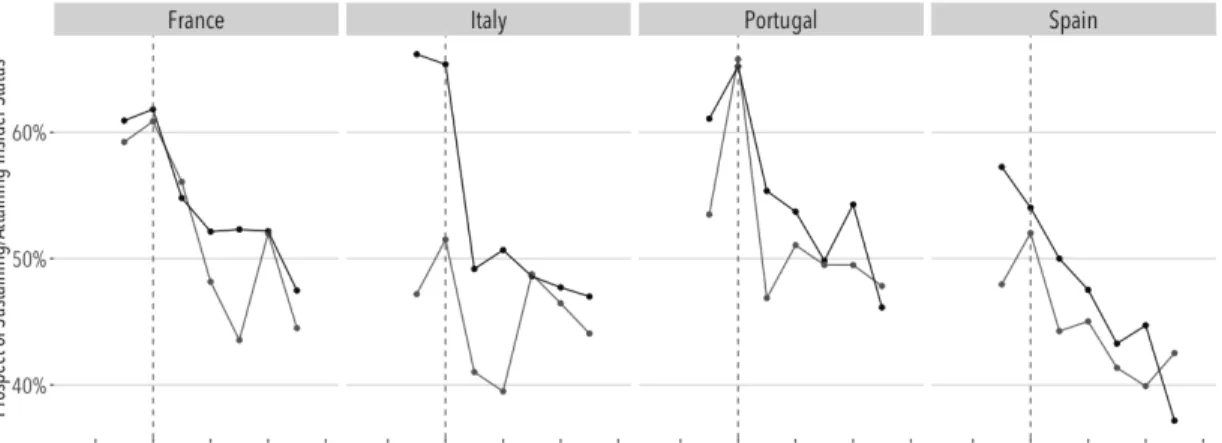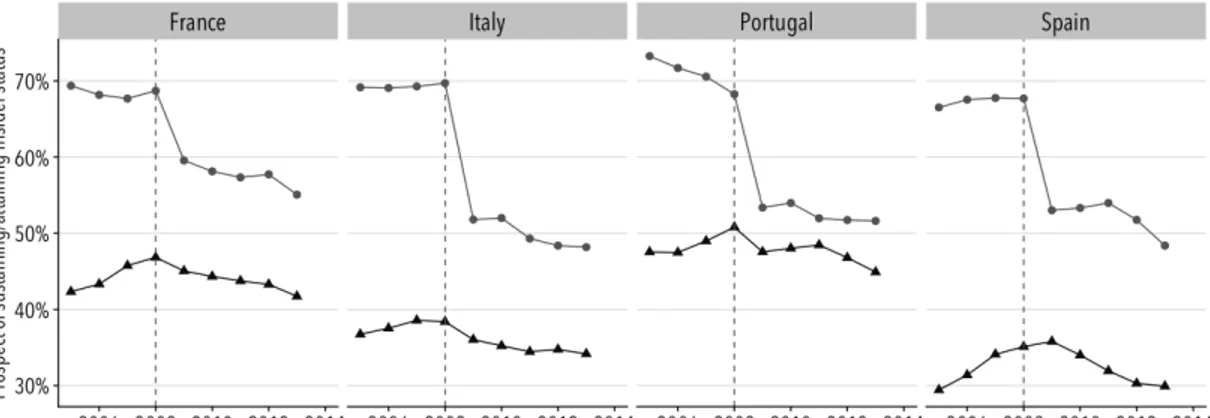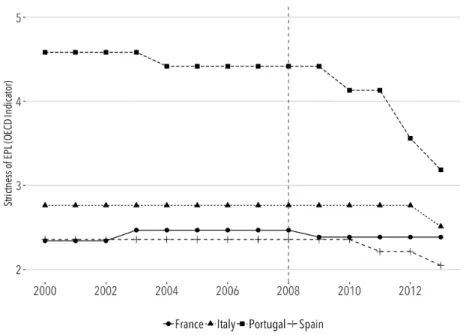Author Author and Author Author
MWP 2020/09
Max Weber Programme
Altered Risks or Static Divides?
Labor Market Inequality during the Great Recession
European University Institute
Max Weber Programme
Altered Risks or Static Divides?
Labor Market Inequality during the Great Recession
Ari Ray and Hanna Schwander
Terms of access and reuse for this work are governed by the Creative Commons Attribution 4.0 (CC-BY 4.0) International license. If cited or quoted, reference should be made to the full name of the author(s), editor(s), the title, the working paper series and number, the year and the publisher.
ISSN 1830-7728
© Ari Ray and Hanna Schwander, 2020
This work is licensed under a Creative Commons Attribution 4.0 (CC-BY 4.0) International license. https://creativecommons.org/licenses/by/4.0/
Published in July 2020 by the European University Institute. Badia Fiesolana, via dei Roccettini 9
I – 50014 San Domenico di Fiesole (FI) Italy
Views expressed in this publication reflect the opinion of individual author(s) and not those of the European University Institute.
Abstract
European countries during the Great Recession had to deal with massive economic shocks, leading to a surge in employment insecurity. How was this increase in employment risk distributed across societal groups? The prominent dualization hypothesis typically posits that outsiders, characterized by low labor market attachment, grow particularly vulnerable to a deterioration of employment prospects during recessions, while insiders remain comparatively sheltered from economic fluctuations. Using panel and cross-sectional data from France, Italy, Portugal and Spain for the pre-crisis, crisis and immediate post-crisis period, we show that this did not hold in Southern Europe during the Great Recession. Instead, employment prospects deteriorated more rapidly for insiders than for outsiders leading to convergence in the labor market conditions of the two groups. We suggest potential explanations for this finding and highlight a future research agenda for dualization scholars.
Keywords
Labor market inequality; Insider-outsider divides; The Great Recession; Euro crisis; Southern Europe
2 July 2020
Ari Ray
Max Weber Fellow 2019-2020, Department of Political and Social Sciences, EUI Hanna Schwander
1. Introduction
The combined effects of the 2008 financial crisis and the euro crisis that followed suit caused more lasting economic damage in Europe than the Great Depression of the 1930s (Crafts2014; Eichengreen and Temin2013). Upon the onset of cri-sis, Eurozone countries hasted to implement large bailout programs to stabilize their financial sectors, in attempts to prevent the crisis from spilling over to the real economy (e.g. Lane2013; Obstfeld2013; O’Rourke and Raylor2013), but in later stages of the crisis, governments were forced to implement tough auster-ity measures, by retrenching welfare state provision and cutting public spending (Blyth2013; Frieden and Walter 2017). Both the crisis itself, as well as the pol-icy responses that followed, had substantial negative effects on aggregate social outcomes, such as unemployment and poverty risks. These have been carefully analyzed in several publications (e.g. Bermeo and Pontusson 2012; Dølvik and Martin 2014; Greve 2012; Raess and Pontusson 2015). In contrast, we know far less of how the Great Recession affected distributions of labor market risks within national populations.
A highly prominent account in political science emphasizes that economic downturns result in increased labor market dualization: that is, a strengthened division of the workforce between well-protected insiders in stable employment and marginally employed outsiders that enjoy a much lower level of social and economic protection.1 Dualization theory leads us to expect that outsiders bear
1See for example Emmenegger et al. (2012); Häusermann and Schwander (2012); Lindbeck
the brunt of crisis-induced risks while protected insiders remain shielded from the vagaries of post-industrial labor markets. In extension, the gap in labor market risk exposure should thus widen between insiders and outsiders during economic downturns.
In this research note, we show that the Great Recession has provided lim-ited evidence, at best, of increasing labor market dualization. Rather, we ob-serve a convergence of risk exposure between insiders and outsiders, as insider employment prospects deteriorate faster than those of outsiders. This finding is based on the analysis of panel and cross-sectional data from four strongly du-alized economies that were all severely affected by the recession: France, Italy, Portugal, and Spain. In closing, we highlight potential mechanisms that may ex-plain the empirical pattern that we uncover and emphasize the need for further research in this field.
2. Theoretical background
Dualization refers to the existence of segmented labor markets, characterized by the co-existence of a primary labor market offering stable, ‘good’ employment conditions for labor market insiders as well as a secondary labor market, with unstable and flexible forms of employment for labor market outsiders (e.g. Lind-beck and Snower1986, 2001). The divide can manifest as structural inequality in national labor markets — i.e. when employment and career prospects vary systematically across different social groups — but it can also take a more
insti-tutional form, when labor markets are divided by regulatory means (employment protection, wage coordination rules), or when social rights are increasingly dif-ferentiated depending on worker employment status.
Within Europe, scholars largely agree that dualization is most pronounced in Continental and Southern Europe. While, historically, the trajectories of these different ‘capitalisms’ into dualization have varied, cross-class alliances between unions, employers and the state are generally considered to be a driving force in both instances. In Continental Europe, dualization is largely the outcome of such an alliance to save industrial core production, in response to recessions in the 1980s and 1990s (Palier and Thelen 2010). High non-wage labor costs in continental Europe increased employer demand for a flexible labor force in an increasingly globalized context (Esping-Andersen1985). Trade unions — as rep-resentatives of insider labor — thus traded employment security in favor of eco-nomic productivity, allowing for the emergence of a secondary labor market that consisted mainly of cheap and atypical employment (Palier and Thelen2010).
In Southern Europe, dualization is sooner theorized to be a structural legacy of the 1960s and 1970s, when demand-led growth models allowed organized labor and capital to engage in competition limitation (Rueda, Wibbels and Al-tamirano 2015). Unionized workers benefitted from this rent-seeking strategy through higher wages and strong employment protection legislation. While this pacification of particularly radical labor movements resulted in additional costs for employers, these costs were comparatively easy for them to shoulder, given the regularity of currency devaluations at the time (Iversen and Soskice2018; Rueda,
Wibbels and Altamirano 2015). Since then, globalization has shortened busi-ness cycles, increasing the necessity of a flexible workforce in Southern Europe too. Policy reforms aimed at liberalizing labor markets have, however, tended towards doing so ‘selectively’ and ‘at the margins’ — thus facilitating the emer-gence of atypical employment forms such as temporary or part-time work, while leaving the privileges of core insiders untouched (Toharia and Malo2000; Regalia
2000).
During economic recessions, dualization accounts argue that employment pro-tection legislation and union power largely shelters insiders from economic fluc-tuations. Firms are, however, still able to adjust to changing macroeconomic conditions as outsiders are subject to much weaker employment protection and function as employment buffers (Rueda2006,2007). Empirically, these theories thus expect outsiders to bear the brunt of employment crises, as they are the first to be made redundant — partly through dismissals, but also via employers reduc-ing workreduc-ing hours and/or relyreduc-ing more heavily on fixed time workers (Boeri and Jimeno2016). Additionally, employment protection reduces the ability of those outside the labor force to (re-)enter the labor market (Emmenegger2009), fur-ther increasing insider-outsider inequality. Consequently, dualization accounts predict outsiders will be faced with ever stronger labor market risks while the employment prospects of the sheltered insiders remain largely intact.
3. Method
Both Continental and Southern European labor market regimes were character-ized by strong dualization at the onset of economic crises in 2008. This held across all four country cases that we analyze in this note: France, Portugal, Italy, and Spain. In contrast, the four countries were affected to varying degrees by the Eurozone financial crisis and also undertook different reform trajectories throughout the recession, thus allowing us to take these factors into account. Our case selection is therefore particularly well-suited to examine developments of insider-outsider divides throughout the Great Recession and to explore the possible causes thereof.
The literature has developed two different conceptualizations of insiders and outsiders: a first one based on the current employment status of individuals and a second one focusing on the exposure of individuals to different forms of em-ployment risk.2 Consequently, we study the employment trajectories of insiders and outsiders for different operationalizations to rule out that our results are driven by specific measurement decisions. We base our analysis on data from the European Survey on Income and Living Conditions (EU-SILC). The sample cov-erage of this survey is unrivaled per country wave, covering an avcov-erage of roughly 13’000 (FR), 26’000 (IT), 5’000 (PT) and 18’000 (ES) respondents per country-year across our selected cases. We also specifically leverage the rotating panel of the survey to measure the trajectories of individual labor market prospects over
2For detailed discussions on the different approaches, see Marx and Picot (2018); Schwander
nine years, spanning 2005 to 2013, covering thus both the pre-crisis, the crisis and the first post-crisis years.3
3.1. Status-based operationalization
A first status-based conceptualization classifies individuals as insiders or outsiders based on their labor market contracts. Following Rueda, we code individuals with permanent employment contracts, as well as voluntary part-time workers with at least 20h per week as insiders (Lindvall and Rueda2014; Rueda2006). Conversely, we consider individuals as outsiders if they work under atypical con-ditions (i.e. if they hold fixed-term contracts, involuntary part-time contracts, or part-time contracts limiting them to work less than 20h per week, within-family employment). We categorize self-employed individuals as insiders if they have employees working for them and outsiders if they do not.4 Our argument focuses on the active part of national labor market pools. As such, we restrict our sample to those in working age (20-65 years) and exclude individuals that are inactive on the labor market: i.e. individuals unable to work due to sickness and/or dis-ability, homemakers, pensioners, students and people pursuing military or social service. Importantly, we also conceptualize the unemployed as a separate labor market group and exclude them from our analysis, while acknowledging that job seekers among the unemployed could also be defined as labor market outsiders. Our decision to examine employed outsiders in isolation is based on our desire to
3Both year-specific panel samples are designed to be representative of national working-age
populations. The number of observations included in the panel data ranges from 3’000 to 11’000 per country-year.
establish an appropriate comparison between insider and outsider groups. Large shares of jobseekers are of course highly employable, but there is good reason to believe that — on average — they are less so than workers with atypical contracts. Based on these measurements, we track individuals across three consecutive years, comparing their labor market status between time points t and t-1. We then compare the capacity of insiders to remain in insider employment with the ability of outsiders to attain an insider position. Aggregating these transitions enables us to analyze group-level probabilities of attaining or sustaining insider-status, over time. The rotating panel of the EU-SILC data tracks the labor market status of each individual over three years, allowing us to analyze two transitions per survey respondent. We opt to include both transitions in this note as this minimizes the risk of potential composition effects of our sample.5. This operationalization in itself represents a strong test of dualization theory for, in all likelihood, one would expect it to be substantially harder for outsiders to gain entry to primary labor markets, than it is for insiders to remain in their current labor market situation — particularly during times of economic downturn.
Finally, as an even stricter version of this operationalization, we also employ a ‘prolonged status’ measurement that considers individuals to be insiders only if they sustain their insider position over two consecutive years. As the results of both operationalizations look broadly similar, we include the findings of the latter in this note’s appendix (see appendix B: figure 3).
5We also perform separate tests excluding the first or second transition of each respondent.
Doing this does not substantially affect our findings and the results of this exercise are included in our appendix (see appendix B: figure 2).
3.2. Risk-based operationalization
For risk-based operationalizations, we draw heavily on work done by Schwander and Häusermann (2013). They classify individuals based on their prospective risk exposure, which is determined by them belonging to an occupational group with an above-average rate of vulnerable employment — i.e. an above-average risk of atypical employment/unemployment. We use a dichotomized version of this measure, which identifies individuals as ‘low risk’ insiders if they belong to an occupational group with below-average rates of atypical work or unemployment before the outbreak of the crisis (reference year is 2007). An extensive overview of this coding procedure is provided in appendix A.
Schwander and Häusermann’s classification is based on risks associated with multiple forms of vulnerable employment: i.e. involuntary part-time employ-ment, temporary employemploy-ment, within-family employemploy-ment, and unemployment. Given that unemployment is arguably the most severe form of ‘outsiderness’, and in line with a political economy literature focusing specifically on unemployment risks (most importantly Rehm 2011, 2016), we additionally test the robustness of our findings by defining insiders and outsiders based on their pre-crisis unem-ployment risks alone (see appendix B: figure 4).
4. Results
Figure 1 displays the main results of our analysis. Split across the four countries we analyze, figure 1a displays the percentage of insiders that were able to sustain
their labor market status, comparing this with the percentage of outsiders that managed to upgrade to an insider status in the following year, between 2005 and 2013. Figure 1b conversely shows the development of risk exposure for ‘low-risk’ insiders and ‘high-risk’ outsiders.
Contrary to the standard predictions of dualization accounts, the analyses re-veal that outsiders are not disproportionally affected by the downturn in any of the four countries examined. For one, we see that sustaining or attaining insider employment grows more difficult for both groups over time (figure 1a). In fact, we find that insider employment prospects deteriorate more strongly than those of outsiders, particularly in the direct aftermath of the economic shock that took place in the direct aftermath of the US Subprime crisis in late 2007. In all coun-tries, our analysis also uncovers convergence of risk exposures between insiders and outsiders over time (figure 1b).
Figure 1:Insider-outsider employment prospects during the Great Recession
(a)Status-based operationalization
(b)Risk-based operationalization: Risk of outsidership
Note: Dashed line demarcates the start of the Great Recession (year 2008). Authors’ calculations are based on EU-SILC panel (figure 1a) and cross-sectional (figure 1b) data.
We also uncover country-specific differences. Our analysis confirms the du-alized nature of labor markets in all four countries before the onset of the cri-sis. Portuguese labor markets, however, stand out in being less so than those of
the other three countries.6 Our status measurements in figure 1a indicate that French insiders faced an 11% decrease in their ability to sustain their insider sta-tus between the years 2008 and 2009, compared to a 9% decrease experienced by French outsiders. The crisis caused markedly stronger effects in Italy, Portugal, and Spain. Italian insiders became 26% less likely to sustain their insider status in the same period, while Italian outsiders became 18% less likely to transition into insider contracts. In Portugal and Spain, convergence of labor market risks started earlier, as pre-crisis growth spurts accelerated the ability of outsiders to transition into insider contracts. By 2009, in Portugal, this positive convergence was replaced by a symmetric deterioration in the ability of both insiders and out-siders to maintain/attain favorable employment contracts in Portugal. Between 2008 and 2009, Portuguese insiders became 13% less likely to sustain their sta-tus, while outsiders became 20% less likely to upgrade. In Spain, as in France and Italy, employment prospects for insiders declined at a more rapid pace than those of outsiders. Between 2008 and 2013, Spanish insiders became 22% less likely to sustain their insider status, while outsiders’ prospects of job upgrading declined by 18%.
In Spain, we also find evidence of so-called ‘risk flips’. Risk flips occur when insiders grow more vulnerable to labor market risks than outsiders in both relative and absolute terms — most typically on account of economic depressions (Rehm
2016). Our findings suggest this took place in two separate instances in Spain. In the years prior to the collapse of the Spanish housing market in 2009, Spanish
outsiders’ prospects of attaining an insider position gradually improved, likely due to the housing boom. In 2006, 59% of outsiders managed to upgrade into insider status, and roughly 65% upgraded in 2008. Conversely, the ability of insiders to retain their contracts remained stable as the initially flattened line for insiders shows. The collapse of the Spanish housing bubble in 2009, however, led to a drastic deterioration of outsiders’ employment prospects, thus reversing this initial risk flip. We find evidence of another risk flip, with more persistent effects, taking place in 2012.
As to the risk-based measurement of insiders and outsiders, our analysis un-covers a negative convergence of insider-outsider labor market prospects across all four selected country cases. In 2005, French workers in low-risk insider groups were 2.0 times more likely to hold desirable labor market contracts in the follow-ing year than those in outsider groups. By 2013, this ratio had diminished to 1.3. Similar patterns of convergence are also detectable in the other three countries examined: Italian and Spanish insiders declined from being 2.2 and 2.5 times more likely to remain insiders, respectively, to less than 1.5 more likely. In Por-tugal, these ratios also decreased, albeit to a lesser extent than in the other three countries: from 1.5 times more likely in 2005 to 1.2 times by 2013.
Thus, while broad trends look similar across all four cases, our findings also indicate country differences that point to the relevance of country-specific fac-tors. Importantly, crisis trajectories varied notably between the four cases. All four countries experienced large negative demand shocks in the aftermath of the Great Recession, resulting in negative GDP growth rates in 2009. But while the
French economy was quick to recover (the country returned to persistent growth as early as 2010 despite persistently high unemployment), recovery remained slug-gish in Italy, Portugal, and Spain. This might explain why employment prospects improved again for French outsiders in 2012 (see figure 1a), as French employers started expanding their pool of permanent workers after the immediate shock is over. In Italy growth returned briefly in 2010/2011, only to turn negative again in 2012 when fears of a banking crisis resurfaced. Portugal also experiences a similar increase in growth in 2010, only to face declining GDP growth again in 2011, upon which the country was forced to accept a sovereign bailout. In Spain, growth was hemmed by the eruption of a substantial banking crisis in 2010 that spilled over to the real economy, despite the government’s efforts to contain it. The resulting insolvencies in the finance, housing and construction sectors — all insider-dominated sectors with a high share of male employment — affected in-siders particularly strongly, likely contributing to the first Spanish risk-flip de-tectable in figure 1a. The strong vulnerability of these sectors to the crisis has been highlighted by some scholars who dub the recession a ‘mancession’ (Perry
2010). Furthermore, to combat the crisis, the Spanish government implemented comprehensive labor market reforms in 2012 (Cioffi and Dubin2016; Pavolini et al. 2015; Picot and Tassarini2017). These reforms aimed to reshape the overall efficiency of the labor market and, especially, to reduce the privileges of insiders by smoothening differences in dismissal costs between temporary and permanent contracts (Wölfl and Mora-Sanguinetti2011). Notably, the second risk flip when insider employment prospects deteriorate to below those of outsiders occurred
di-rectly after the enactment of these structural reforms. We conjecture that this risk flip is thus likely caused by reform implementation and the sector-specific pattern of the mansession.
5. Avenues for further research
In closing this note, we discuss potential explanations for the patterns that our analysis has uncovered, as well as how our findings may spur further research and advance our theoretical reflections on labor market dualization. Our findings point to two possible causes for convergence between insiders and outsider em-ployment prospects. First, the Great Recession substantially differs from previous crises upon which dualization theory is based. The magnitude of the economic shock during the period by far exceeded that of any shock described by exist-ing dualization accounts. More specifically, the crisis strongly affected domestic banking sectors, draining access to credit and causing unemployment to surge as a result of firm insolvencies (Boeri and Jimeno2016). Economic shocks that lead to an increase in insolvency rates, rather than a decrease in aggregate demand, do not allow employers to engage in strategic labor shedding. Essentially, when a firm goes bankrupt, all workers become redundant — regardless of their employ-ment contract. As such, we suggest that shocks leading to banking crises likely lead to a symmetric increase in unemployment risk for insiders and outsiders.
Second, the Great Recession hit already strongly dualized labor markets. This conditions possible responses as selective flexibilization was no longer a viable
path to economic adjustment. It was, rather, considered part of the problem, as wages and employment prospects did not correspond to productivity levels (John-ston2016). Countries such as Spain were accordingly pressured to lower protec-tion legislaprotec-tion for standard employment and to flexibilize the domestic wage bar-gaining system (Wölfl and Mora-Sanguinetti 2011; Pavolini et al. 2015). In other words, the crisis had short-term cyclical effects but affected also more persistent institutional arrangements in ways that directly disadvantaged labor market in-siders. This suggests that if crisis persists in highly dualized contexts demands for structural reforms increase. Depending on whether these demands translate into government action or not, we expect to see evidence of risk flips between insiders and outsiders as the short-term effects of flexibilization asymmetrically hit insiders.7
More broadly, our findings challenge conventional dualization theory that considers institutional dualization as a gradual process. During major shocks, crucial actors such as the state, trade unions or employers might act differently than during times of economic normalcy. If employers, for instance, consider shocks as persistent, their incentive to retain surplus labor throughout the reces-sionary spell decreases, as the cost of labor hoarding becomes larger than the cost of rehiring workers upon the end of the recession. Simultaneously, the bargaining power of organized labor, as the main representatives of insiders, is substantially weakened in the aftermath of crises (Culpepper and Regan2014; Culpepper and
7Theoretically, this pattern has been discussed by Rehm (2016), who argues that uncertainty
in the aftermath of the Great Depression likely led to more homogenous exposure of individuals to employment risks.
Reinke2014) — in particular, if countries are pressured into reforms by supra-national institutions. These combined factors, we argue, should diminish the probability of increased dualization in the event of large-scale economic shocks.
Our results also run counter to accounts that attribute developments in in-sider/outsider inequality mainly to changes in national employment protection legislation. For we find evidence of convergence between the two labor market groups, even in cases such as France and Italy, where employment protection for regular workers remained largely unaltered throughout the period analyzed in this note.8 Theory derived from previous European recessions of the 1980s and 1990s, may not hold during the Great Recession as substantial depressions seemingly represent a ‘force majeur’ during which employment protection can no longer sufficiently shelter core workers. We, therefore, suggest that key as-sumptions of the insider-outsider model do not hold in the context of substantial economic depressions and probe the dualization literature to expand its theoreti-cal framework to incorporate events such as the Great Recession.
The looming question in our view is whether the deviation from the structural pattern of dualization that we uncover is persistent or transitory: in other words, whether insiders and outsiders’ employment trajectories will continue to converge or if labor markets will grow more unequal again once the turmoil is over. We highlight this as a fruitful avenue for future research. The fact that many countries have implemented structural reform leaves us hopeful for a continued narrowing of the insider-outsider gap. Worryingly, this convergence is however mainly a
‘downward’ convergence —– insiders now face more substantial risks than before and employment prospects for outsiders have advanced far from satisfactorily. This, combined with prolonged under-investment in social investment policies such as education, childcare, and active labor market policies in the Eurozone South (Bonoli2013), prevents us from closing this note with an optimistic outlook on future European labor market developments.
References
[1] Bermeo, N. & Pontusson, J. (2012). Coping with Crisis. Government Reac-tions to the Great Recession.
[2] Blyth, M. (2013). Austerity: the history of a dangerous idea. Oxford Univer-sity Press.
[3] Boeri, T. & Jimeno, J. F. (2016). Learning from the Great Divergence in unemployment in Europe during the crisis. Labour Economics, 41, 32–46. [4] Bonoli, G. (2013). The origins of active social policy: Labour market and
childcare policies in a comparative perspective. Oxford, UK: Oxford University
Press.
[5] Cioffi, J. W. & Dubin, K. A. (2016). Commandeering crisis: Partisan labor repression in Spain under the guise of economic reform. Politics and Society, 44(3), 423–453.
[6] Crafts, N. (2014). What Does the 1930s’ experience tell us about the future of the Eurozone? Journal of Common Market Studies, 52(4), 713–727. [7] Culpepper, P. & Regan, A. (2014). Why don’t governments need trade unions
anymore? The death of social pacts in Ireland and Italy. Socio-Economic
Re-view, (July 2012), 1–23.
[8] Culpepper, P. & Reinke, R. (2014). Structural Power and Bank Bailouts in the United Kingdom and the United States. Politics & Society, 42(4), 427–454. [9] Dølvik, J. E. & Martin, A. (2014). European Social Models From Crisis to
Crisis: Employment and Inequality in the Era of Monetary Integration.
[10] Eichengreen, B. & Temin, P. (2013). Fetters of Gold and Paper. In N. Crafts & P. Fearon (Eds.), The Great Depression of the 1930s: Lessons for Today chapter 14, (pp. 429–448). Oxford, UK: Oxford University Press.
[11] Emmenegger, P. (2009). Barriers to entry: insider/outsider politics and the political determinants of job security regulations. Journal of European Social
Policy, 19(2), 131–146.
[12] Emmenegger, P., Häusermann, S., Palier, B., & Seeleib-Kaiser, M. (2012).
The age of dualization: the changing face of inequality in deindustrializing societies. OUP USA.
[13] Esping-Andersen, G. (1985). Politics against markets: The social democratic
road to power. Princeton, NJ: Princeton University Press, reprint edition.
[14] Frieden, J. & Walter, S. (2017). Understanding the Political Economy of the Eurozone Crisis. Annual Review of Political Science, 20(1), 371–390.
[15] Greve, B. (2012). The Times They are Changing?: Crisis and the Welfare
State, volume 8. John Wiley & Sons.
[16] Häusermann, S. & Schwander, H. (2012). Varieties of dualization? Labor market segmentation and insider-outsider divides across regimes. The age of
dualization: The changing face of inequality in deindustrializing societies, (pp.
27–51).
[17] Iversen, T. & Soskice, D. (2018). A Structural-Institutional Explanation of the Eurozone Crisis. In P. Manow, B. Palier, & H. Schwander (Eds.),
Wel-fare Democracies and Party Politics: Explaining Electoral Dynamics in Times of Changing Welfare Capitalism (pp. 257–280). Oxford: Oxford University
Press.
[18] Jessoula, M., Graziano, P. R., & Madama, I. (2010). Selective Flexicurity in segmented labour markets: the case of Italian ’mid-siders’. Journal of Social
Policy, 39(4), 561–583.
[19] Johnston, A. (2016). From Convergence to Crisis: Labor Markets and the
Instability of the Euro. Cornell University Press.
[20] Kitschelt, H. & Rehm, P. (2005). Work, Family, and Politics: Foundations of Electoral Partisan Alignments in Postindustrial Democracies. In Annual
Meeting of the American Political Science Association, Washington, DC (pp.
1–4).
[21] Lane, P. R. (2013). The European Sovereign Debt Crisis. Journal of
Eco-nomic Perspectives, 26(3), 49–67.
[22] Lindbeck, A. & Snower, D. J. (1986). Wage setting, unemployment, and insider-outsider relations. American Economic Review, 76(2), 235–239. [23] Lindbeck, A. & Snower, D. J. (1988). Cooperation, harassment, and
in-voluntary unemployment: an insider-outsider approach. American Economic
Review, (pp. 167–188).
[24] Lindbeck, A. & Snower, D. J. (2001). Insiders versus Outsiders. Journal of
Economic Perspectives, 15(1), 165–188.
[25] Lindvall, J. & Rueda, D. (2014). The Insider–Outsider Dilemma. British
Journal of Political Science, 44(02), 460–475.
[26] Marx, P. & Picot, G. (2018). Three Approaches to Labour Market Vulner-ability and Political Preferences. Political Science Research and Methods. [27] Obstfeld, M. (2012). Financial flows, financial crises, and global imbalances.
Journal of International Money and Finance, 31(3), 469–480.
[28] Obstfeld, M. (2013). Finance at center stage: some lessons of the euro crisis. [29] OECD (2020). Strictness of employment protection legislation: individual
and collective dismissals.
[30] Oesch, D. (2006). Coming to Grips with a Changing Class Structure.
Inter-national Sociology, 21, 263–288.
[31] O’Rourke, K. H. & Taylor, A. M. (2013). Cross of Euros. The Journal of
Economic Perspectives, 27(3), 167–192.
[32] Palier, B. & Thelen, K. (2010). Institutionalizing Dualism: Complementar-ities and Change in France and Germany. Politics & Society, 38(1), 119–148. [33] Pavolini, E., León, M., Guillén, A. M., & Ascoli, U. (2015). From austerity to permanent strain? The EU and welfare state reform in Italy and Spain.
[34] Perry, M. J. (2010). The Great Mancession of 2008-2009. Statement before the House Ways and Means Committee.
[35] Picot, G. & Tassinari, A. (2017). All of one kind? Labour market reforms under austerity in Italy and Spain. Socio-Economic Review, 15(2), 461–482. [36] Raess, D. & Pontusson, J. (2015). The politics of fiscal policy during
eco-nomic downturns, 1981-2010. European Journal of Political Research, 54(1), 1–22.
[37] Regini, M. (2000). Between deregulation and social pacts: The responses of European economies to globalization. Politics & Society, 28(1), 5–33.
[38] Rehm, P. (2011). Social Policy by Popular Demand. World Politics, 63(2), 271–299.
[39] Rehm, P. (2016). Risk inequality and welfare states: social policy
prefer-ences, development, and dynamics. Cambridge University Press.
[40] Rovny, A. E. & Rovny, J. (2017). Outsiders at the ballot box: Opera-tionalizations and political consequences of the insider-outsider dualism.
Socio-Economic Review, 15(1), 161–185.
[41] Rueda, D. (2006). Social Democracy and Active Labour-Market Policies : Insiders , Outsiders and the Politics of Employment. British Journal of Political
Science, 36(3), 385–406.
[42] Rueda, D. (2007). Social democracy inside out: Partisanship and labor
mar-ket policy in advanced industrialized democracies. Oxford University Press on
Demand.
[43] Rueda, D., Wibbels, E., & Altamirano, M. (2015). The Origins of Dualism. In P. Beramendi, S. Häusermann, H. Kitschelt, & H. Kriesi (Eds.), The Politics
of Advanced Capitalism (pp. 89–111). New York: Cambridge University Press.
[44] Saint-Paul, G. (1998). A framework for analyzing the political support for active labor market policy. Journal of Public Economics, 67(2), 151–165. [45] Saint-Paul, G. (2002). The Political Economy of Employment Protection.
[46] Schwander, H. & Häusermann, S. (2013). Who is in and who is out? A risk-based conceptualization of insiders and outsiders. Journal of European
Social Policy, 23(3), 248–269.
[47] Toharia, L. & Malo, M. A. (2000). The Spanish experiment: pros and cons of flexibility at the margin. In G. Esping-Andersen & M. Regini (Eds.), Why
deregulate labour markets? (pp. 307–335). Oxford: Oxford University Press.
[48] Wölfl, A. & Mora-Sanguinetti, J. S. (2011). Reforming the Labour Market in Spain.
Appendix
A. Measurement and coding
A.1. Risk-based insider/outsider classification
Our dictonomous risk-based indicator of insider and outsider status draws on the methodology of Schwander and Häusermann (2012,2013) and was attained in two steps. First, we classified workers on the basis of their gender, age and occupational group to generate a three-dimensional class schema drawing on EU-SILC data.
For this purpose, we rescaled age and occupational information provided in the EU-SILC dataset. Age was dictomized into two age brackets: young prime-age
workers, aged 20 - 39, and old prime-age workers, aged 40-60. Persons below the
age of 20 and above 60 were excluded from the analysis, as we focus paricularly on labor market groups with stronger levels of labor market attachment.
As a first occupation-based dimension of class, we drew on conceptualiza-tions by Kitschelt and Rehm (2005) and Oesch (2006) of occupational divisions
mulators’, ‘Mixed-service functionaries’, ‘Blue and lower white collar workers’, ‘Socio-cultural (semi-)professionals’ and ‘Low service functionaries’. We coded
these groups by means of re-scaling personal two-digit ISCO occupational codes, contained in the EU-SILC dataset. EU-SILC reporting standards changed in 2012: occupational data recorded is provided according to the ISCO-88 classification in the period of 2004-2011, and ISCO-08 standards starting year 2012. Because of this, we drew on a combination of both classification schemes during coding. Table 1 provides an overview of theorized occupational groups, as well as how ISCO-numbered occupations were conceptualized to belong to these groups.
In order to attain a three-dimensional class schema, we thereafter dissaggre-gated the five occupational groups along gender and age lines in order to attain 20 distinct socio-economic groups, as displayed in Table 2. Outsider risk was relatively static prior to the onset of the Great Recession —– as such, we chose simply to index status to the most relevant pre-crisis year: 2007. While the Great Financial Crisis is commonly conceptualized to have begun already in September 2007 with the onset of the American Sub-prime crisis (Lane2013; Obstfeld2012; O’Rourke and Taylor2013), the employment effects of this crisis in Europe were only really experienced by the start of 2008 (Boeri and Jimeno2016). Given this, we retained 2007 as an index year.
Table 1:ISCO-code based occupational coding scheme of EU-SILC data
ISCO Rev. 1988 Classification (2004-2011) ISCO Rev. 2008 Classification (2012-2014)
‘Capital accumulators’
Legislators and senior officials (ISCO 88-11) Chief executives, senior officials and legislators (ISCO 08-11) Corporate managers (ISCO 88-12) Administrative and commercial managers (ISCO 08-12) Managers of small enterprises (ISCO 88-13) Production and specialized services managers (ISCO 08-13) Physical, mathematical and engineering Hospitality, retail and other services managers (ISCO 08-14)
science professionals (ISCO 88-21) Science and engineering professionals (ISCO 08-21) Self-employed legislators, senior officials, Business and administration professionals (ISCO 08-24)
managers and Professionals (ISCO 88-11:24) TCT technology professionals (ISCO 08-25)
Self-employed Managers and Professionals (ISCO 08-11:26)
‘Mixed service functionaires’
Office clerks (ISCO 88-41) Science and engineering associate professionals (ISCO 08-31) Customer services clerks (ISCO 88-42) Business and administration associate
Physical and engineering science professionals (ISCO 08-33)
associate professionals (ISCO 88-31) Information and communications technicians (ISCO 08-35) Self-employed non-professionals (ISCO 88-31:93) General and keyboard clerks (ISCO 08-41)
Customer services clerks (ISCO 08-42)
Numerical and material recording clerks (ISCO 08-43) Other clerical support workers (ISCO 08-44) Self-employed non-professionals (ISCO 08-31:96)
‘Blue and lower white collar workers’
Skilled agricultural and fishery workers (ISCO 88-61) Market-oriented skilled agricultural workers (ISCO 08-61) Extraction and building trades workers (ISCO 88-71) Market-oriented skilled forestry, fishery
Metal, machinery and related trades workers (ISCO 88-72) and hunting workers (ISCO 08-62) Precision, handicraft, craft printing and Subsistence farmers, fishers,
related trades workers (ISCO 88-73) hunters and gatherers (ISCO 08-63) Other craft and related trades workers (ISCO 88-74) Building and related trades workers (ISCO 08-71) Stationary plant and related operators (ISCO 88-81) Metal, machinery and related trades workers (ISCO 08-72) Machine operators and assemblers (ISCO 88-82) Handicraft and printing workers (ISCO 08-73)
Drivers and mobile plant operators (ISCO 88-83) Electrical and electronics trades workers (ISCO 08-74) Agricultural, fishery and related labourers (ISCO 88-92) Food processing, woodworking, garment and other craft Labourers in mining, construction, and related trades workers (ISCO 08-75)
manufacturing and transport (ISCO 88-93) Stationary plant and machine operators (ISCO 08-81) Assemblers (ISCO 08-82)
Drivers and mobile plant operators (ISCO 08-83) Agricultural, forestry and fishery labourers (ISCO 08-92) Labourers in mining, construction, manufacturing and
transport (ISCO 08-93)
ISCO-code based occupational coding scheme of EU-SILC data (contd.)
ISCO Rev. 1988 Classification (2004-2011) ISCO Rev. 2008 Classification (2012-2014)
‘Socio-cultural (semi-)professionals’
Life science and health professionals (ISCO 88-22) Health professionals (ISCO 08-22) Teaching professionals (ISCO 88-23) Teaching professionals (ISCO 08-24)
Other professionals (ISCO 88-24) Legal, social and cultural professionals (ISCO 08-26) Life science and health associate professionals (ISCO 88-32) Health associate professionals (ISCO 08-32) Teaching associate professionals (ISCO 88-34) Legal, social, cultural and related
Other associate professionals (ISCO 88-34) associate professionals (ISCO 08-34)
‘Low service functionaires’
Personal and protective services workers (ISCO 88-51) Personal services workers (ISCO 08-51) Models, salespersons and demonstrators (ISCO 88-52) Sales workers (ISCO 08-52)
Sales and services elementary occupations (ISCO 88-91) Personal care workers (ISCO 08-53) Sales and services elementary occupations (ISCO 88-91) Protective services workers (ISCO 08-54)
Cleaners and helpers (ISCO 08-91) Food preparation assistants (ISCO 08-94)
Street and related sales and services workers (ISCO 08-95)
Note: ISCO occupational codes provided in brackets. For full descriptions of ISCO-88 and ISCO-08 occupational
Table 2:Pre-crisis distribution of sampled workers across socio-economic risk groups (year 2007)
Country Occupational group Young prime-age workers Old prime-age workers
France Capital accumulators 2.79% 1.18% 4.34% 1.87%
Mixed service functionaries 3.99% 5.73% 5.51% 7.03% Blue and lower white collar workers 9.13% 2.11% 10.58% 2.91% Socio-cultural (semi-)professionals 3.12% 6.21% 4.36% 7.19%
N = 11’914 Low service functionaries 2.40% 7.53% 2.29% 9.72%
Italy Capital accumulators 1.56% 0.80% 2.57% 1.16%
Mixed service functionaries 7.46% 6.33% 9.65% 6.71% Blue and lower white collar workers 9.48% 3.87% 9.86% 5.03% Socio-cultural (semi-)professionals 2.63% 5.87% 3.90% 7.27%
N = 23’812 Low service functionaries 2.81% 5.22% 2.67% 5.15%
Portugal Capital accumulators 1.28% 0.64% 2.62% 0.97%
Mixed service functionaries 4.24% 5.21% 5.74% 7.10% Blue and lower white collar workers 11.56% 3.78% 13.85% 6.31% Socio-cultural (semi-)professionals 1.85% 3.41% 2.38% 4.00%
N = 5’452 Low service functionaries 3.78% 7.70% 3.25% 10.33%
Spain Capital accumulators 1.67% 0.76% 2.39% 0.70%
Mixed Service Functionaries 4.50% 6.48% 6.39% 6.46% Blue and lower white collar workers 12.19% 3.07% 11.12% 4.01% Socio-cultural (semi-)professionals 2.27% 4.49% 3.33% 4.23%
N = 16’598 Low service functionaries 3.81% 9.27% 3.33% 9.54%
Table 3:Risk-based coding of socio-economic groups (Dictomous, 2007 as reference year)
Country Occupational group Young prime-age workers Old prime-age workers
France Capital accumulators Male Female Male Female
Mixed service functionaries Male Female Male Female Blue and lower white collar workers Male Female Male Female Socio-cultural (semi-)professionals Male Female Male Female Low service functionaries Male Female Male Female
Italy Capital accumulators Male Female Male Female
Mixed service functionaries Male Female Male Female Blue and lower white collar workers Male Female Male Female Socio-cultural (semi-)professionals Male Female Male Female Low service functionaries Male Female Male Female
Portugal Capital accumulators Male Female Male Female
Mixed service functionaries Male Female Male Female Blue and lower white collar workers Male Female Male Female Socio-cultural (semi-)professionals Male Female Male Female Low service functionaries Male Female Male Female
Spain Capital accumulators Male Female Male Female
Mixed Service Functionaries Male Female Male Female Blue and lower white collar workers Male Female Male Female Socio-cultural (semi-)professionals Male Female Male Female Low service functionaries Male Female Male Female
B. Robustness
In order to increase our confidence in our findings, we undertook a number of robustness checks employing alternative definitions of the insider/outsider divide. Below we present the results of additional analyses.
B.1 Alternative operationalizations of insiders & outsiders
Status-based operationalizations
The rotating panel of the EU-SILC data tracks the labor market status of each in-dividual over three years, meaning that we track two labor transitions per survey respondent. Given this, we also run separate tests excluding the first or second transition of each respondent. Doing this does not fundamentally affect our find-ings, as the overall rate at which insiders transition out of insider employment conditions remains higher than the rate at which outsiders transition into insider employment. The results of the exercize are displayed in figure 2. In examining individual-level change and continuity over a singular annual threshhold, group trends become more volatile. As per-year respondent samples are designed to be nationally representative, this increased volatility is likely caused by the fact that respondent pools grow more biased when we subset our data to look only at the first/last transition of each individual.
Figure 2:Status-based operationalization: Only one transition per individual
(a)Only first transition
(b)Only last transition
As a stricter version of our status operationalization, we also performed our analysis when employing a prolonged status definition of insiders and outsiders. This definition considers individuals to be insiders only if they sustain their insider position over two consecutive years prior to our year of interest (i.e. at t-1 and t-2), and, similarly, individuals to be outsiders only if they remain in atypical employment over two consecutive years prior to our year of interest.
Employing this operationalization alters our findings in two main ways, as displayed in figure 3. First, in France the convergence trend between insiders and outsiders no longer holds after 2010. Still, French outsiders do not seemingly bear the brunt of employment shock in the aftermath of the crisis, as employment prospects deteriorate more strongly for insiders after 2008. Second, we detect slight evidence of a risk-flip taking place in 2008 in Portugal, but can no longer find the same for this occurring in Spain during this time. Overall however, the broad trajectories displayed suggest the same pattern as in our primary analysis: employment prospects for insiders deteriorate faster during the period, than they do for outsiders.
Figure 3:Status-based operationalization: Prolonged labor market status
Dashed lines demarkate start of the Great Recession (year 2008).
Risk-based operationalization
Given that unemployment might be the most severe form of ‘outsiderness’, and in line with a political economy literature focusing specifically on unemployment risks, we additionally test the robustness of our findings by defining insiders and outsiders based solely on their pre-crisis unemployment risk exposure. Using the same class schema elaborated upon in above in table 2, we classifed individuals on the basis of their 2007 risk exposure to unemployment alone, where workers with average or below exposure to unemployment were coded as insiders, and others were coded as outsiders. Overall, employing this alternative operationalization does very little to change our findings as seen below in Figure 4.
Figure 4:Risk-based operationalization: Only unemployment risk
C. Employment protection legislation
Figure 5:Development of employment protection legislation in France, Italy, Portugal and Spain
Note: Based on OECD employment protection strictness indicator of regular contracts (individual & collective dismissals, version 1), scaled 0-5 (OECD2020)
